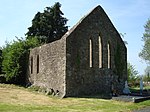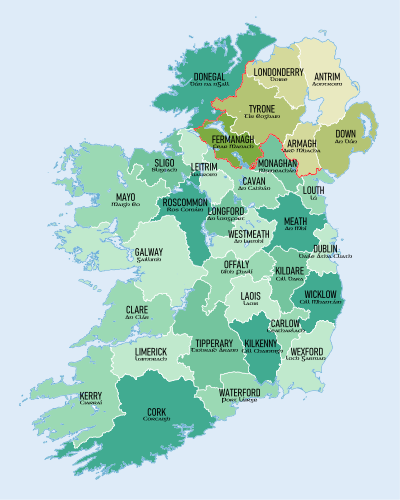Abbreviations and Key
| * | current monastic function |
|---|---|
| + | current non-monastic ecclesiastic function |
| ^ | current non-ecclesiastic function |
| = | remains incorporated into later structure |
| # | no identifiable trace of the monastic foundation remains |
| ~ | exact site of monastic foundation unknown |
| ø | possibly no such monastic foundation at location |
| ¤ | no such monastic foundation |
| ≈ | identification ambiguous or confused |
Locations with names in italics indicate probable duplication (misidentification with another location) or non-existent foundations (either erroneous reference or proposed foundation never implemented).
| NIEA | Scheduled Monument (NI) |
| NM | National Monument (ROI) |
| C.I. | Church of Ireland |
| R.C. | Roman Catholic Church |
| Foundation | Image | Communities & Provenance | Formal Name or Dedication & Alternative Names | OnLine References & Location |
|---|---|---|---|---|
| Abbeyderg Abbey |  | Augustinian Canons Regular founded before 1216 (during the reign of King John) probably by Gormgall O'Quinn; raised to abbey status after 1487? dissolved 1540; restored?, occupied by John O'Ferral, previously abbot, 1548, by assignment of Sir Thomas Cusak; granted to Nicholas Ailmer, termor | St Peter ____________________ Monaster-darig; Monaster-deirg; Monaster-derick | 53°38′17″N7°47′15″W / 53.638097°N 7.787483°W |
| Abbeylara Abbey |  | Cistercian monks — from St Mary's, Dublin founded c.1210 by Sir Richard Tuit; colonised 1214; dissolved 1540 | Leathragh; Laragh; Leathan; Monaster-Lethratha; Granard | 53°45′52″N7°26′46″W / 53.764559°N 7.446135°W |
| Abbeyshrule Abbey |  | Cistercian monks — from Mellifont founded 1200 by the O'Ferral family; affiliation changed to Bective 1228; dissolved 1569; suppressed by Queen Elizabeth, 1592; (NM) | Flumen Dei; Sruthair; Schrowl | 53°34′47″N7°39′29″W / 53.5798036°N 7.6581627°W |
| Ardagh Monastery |  | early monastic site founded 5th century by St Patrick or St Mel? diocesan cathedral 1111 | Ardachad | 53°40′02″N7°41′33″W / 53.6671207°N 7.6925915°W |
| Ballynasaggart Friary | Franciscan Friars, Third Order Regular founded after 1510? by Geoffrey O'Ferrall; dissolved 1540; Observant Franciscan Friars refounded 1634; dissolved 1811 | St John the Baptist Friary (from 1634) ____________________ Ballinasaggart; Baile-na-sagart; Baile-ne-saggard | [1] 53°41′29″N7°37′21″W / 53.691250°N 7.622591°W | |
| Cashel Monastery | Augustinian Canons Regular ruins near parish church purportedly remains of a foundation dependent on Inchcleraun [notes 1] | 53°35′30″N7°58′44″W / 53.591572°N 7.978842°W ? | ||
| Clonbroney Abbey | early monastic site, nuns purportedly founded 5th century by St Patrick; dissolved after 1163 | Cluain-bronaig; Cluain-ebrone | 53°45′04″N7°36′52″W / 53.751083°N 7.614539°W | |
| Cloondara Monastery | early monastic site, probable patron St Ernan of Cloneogher, 6th century | Cluain-da-ratha; Cluain-daragh | 53°43′57″N7°54′26″W / 53.732593°N 7.907217°W | |
| Cloneogher Monastery | early monastic site, patron St Ernan, 6th century (in the time of St Colmcille) | Cluain-deochra; Clonogherie; Clonoghrir | 53°43′13″N7°56′19″W / 53.720355°N 7.938566°W (approx) | |
| Druim-cheo Nunneryø~ | purported early monastic site, nuns — evidence lacking | Druim-chea; Bawn? | 53°40′31″N7°48′14″W / 53.675409°N 7.803855°W (approx?) | |
| Forgney Monastery | early monastic site, founded 5th century by St Patrick | Forgnaide | 53°32′43″N7°40′59″W / 53.545408°N 7.682984°W (approx) | |
| Granard Monastery | early monastic site, founded 5th century by St Patrick, granted by Coirpre's sons | Granairud; Granard Kill | 53°46′42″N7°29′34″W / 53.778277°N 7.492762°W (approx.) | |
| Inchbofin Monastery | Former county location. See List of monastic houses in County Westmeath | |||
| Inchcleraun Priory | early monastic site, founded 6th century (c.540 or probably earlier) by St Diarmuid (Dermod); Augustinian Canons Regular (— Arroasian)? refounded after 1140; plundered several times; plundered 1098 by O'Brien dissolved c.1541 | Inis-clothrann; Inis-cloghran; Quaker Island | 53°34′57″N8°00′23″W / 53.5823814°N 8.0064049°W | |
| Inchmore Priory, Lough Gowna | early monastic site, founded 6th century by St Colmcille Augustinian Canons Regular (— Arroasian)? dependent on Louth refounded after 1140; dissolved 1540, surrendered 8 October 1540; occupied by Lyosagh O'Ferral by 1548, by assignment with Sir Thomas Cusacke; leased to James Nugent 1560 | St Mary (from Augustinian refoundation, after 1140) ____________________ Inismor-Loch-Gamna; Inchymory; Columbkille, Lough Gawna/Lough Gowna; Teampull Choluim Cille (early church) | 53°49′23″N7°34′04″W / 53.8230512°N 7.567728°W | |
| Inchmore Priory, Lough Ree | Former county location. See List of monastic houses in County Westmeath | |||
| Kilcommoc Friary | Dominican Friars — probable place of refuge after expulsion from Longford | Kil-comin; Kil-cumin | [2] 53°36′07″N7°48′48″W / 53.6019789°N 7.8133177°W (possible) | |
| Kilglass Monastery | possible early monastic site, nuns possibly founded 5th century by St Eiche, sister of St Mel and niece of St Patrick | Cell-glaissi | [3] 53°37′56″N7°39′11″W / 53.632218°N 7.6530075°W | |
| Kilmodain Monastery | early monastic site | Abbey of St Modan; Cell-muadain, in Kilmahon? | 53°48′59″N7°45′06″W / 53.8164886°N 7.751584°W (approx) | |
| Longford Friary +? | Dominican Friars founded 1400 by ——— O'Farrel; Regular Observant Dominican Friars reformed before 1429; dissolved 1540-1, nominally suppressed; friars probably remained in occupation granted to Richard Nugent 1566-7; dissolved 1578?; granted to Sir Nicholas Malby 1578; granted to Francis, Vicount Valentia 1615; restored to the friars 1641 during the Confederation; friars' church in use by the Protestants until mid-19th century; St John's C.I. parish church built on site, possibly incorporating some of the material from the friars' church | St Brigid ____________________ Latoria; Longphort | 53°43′53″N7°47′59″W / 53.7313233°N 7.7997969°W | |
| Longford Monasteryø | mistakenly-purported early monastic site [notes 2] | |||
| Raithin Monastery ~ | early monastic site, founded 5th century by St Patrick | Raithen; possibly Leath Rath, [notes 3] near Longford | ||
| Saints Island Priory, Lough Ree | dubious early monastic site founded before 542 by Ciaran; [notes 4] Augustinian Canons Regular founded before 1200 by a descendant of Sir Henry Dillon of Drumrany; dissolved after 1600?; Augustinian Friars founded 1643 | All Saints; Inis-na-naomh; Oilean-na-naomh; Insula Omnium Sanctorum; Insula Sacra; Holy Island | 53°33′17″N7°53′37″W / 53.5547835°N 7.8936341°W | |
